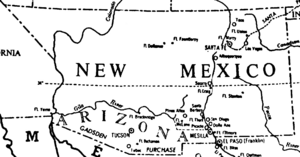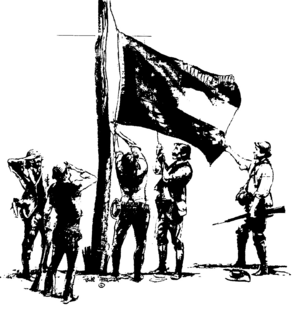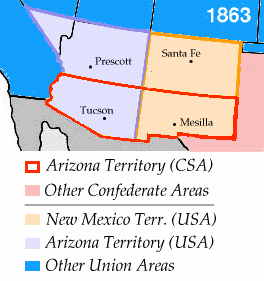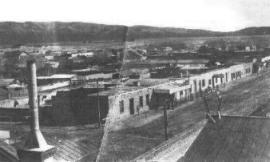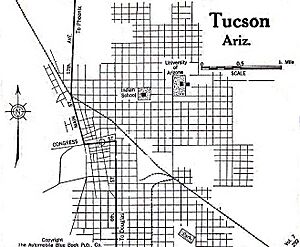History of Tucson, Arizona facts for kids
The history of Tucson, Arizona goes back thousands of years. Early people, called Paleo-Indians, lived in the Santa Cruz River Valley. They grew plants and hunted animals from about 10,000 BCE or even earlier. Later, around 1,200 BCE, people started building irrigation canals. These were some of the first in North America. The Hohokam people lived in the Tucson area from about 450 to 1450 CE. They had a complex society that focused on farming.
In 1700, a Jesuit missionary named Eusebio Francisco Kino started the Mission San Xavier del Bac. During the 1700s, Spanish missionaries tried to get Native Americans to become Catholic and live like the Spanish. The Spanish built a fort in Tubac in 1751. This fort was moved to Tucson in 1775. There, Hugo O'Conor, an Irishman working for Spain, officially founded the Presidio San Augustin del Tucson.
The Spanish stayed in the area, fighting many attacks from Apache warriors. In 1821, Tucson became part of the new state of Sonora in Mexico. Mexico had won its freedom from Spain. In 1854, the United States bought Tucson and much of the land around it from Mexico. This was part of the Gadsden Purchase. Tucson then became part of the New Mexico Territory. In 1863, President Lincoln created the Arizona Territory. Tucson was its capital from 1867 to 1877. On February 14, 1912, Arizona became the 48th state in the United States.
Contents
Early People and Spanish Arrival
Tucson was first visited by Paleo-Indians about 12,000 years ago. Recent digs near the Santa Cruz River found a village site from 2100 BCE. People farmed a lot along the Santa Cruz River from about 1200 BCE to 150 CE. They built irrigation canals and grew corn, beans, and other crops. They also gathered wild plants and hunted.
Later, people started using pottery for cooking and storage. The Hohokam people lived here from 600 to 1450 CE. They were known for their huge irrigation canals and their special red-on-brown pottery.
Jesuit missionary Eusebio Francisco Kino visited the Santa Cruz River valley in 1692. He founded the Mission San Xavier del Bac in 1700. This mission was about 7 miles (11 km) upstream from where Tucson is today. A separate settlement was started downstream near "A" mountain. Hugo Oconór, who helped found Tucson, approved building a military fort there. This fort, called Presidio San Agustín del Tucsón, was started on August 20, 1775. It was near the current downtown Pima County Courthouse. During the Spanish time, Apaches often attacked the fort. One famous attack was the Second Battle of Tucson. Eventually, the town was called "Tucson." It became part of Sonora, Mexico, after Mexico became free from Spain in 1821.
Tucson Under Mexican Rule
In 1821, Mexico became independent from Spain. The Mexican state of Occidente included Tucson. In 1853, the United States bought a strip of land from Mexico. This land included Tucson and was part of the Gadsden Purchase. This land was later used to build a railroad across the country.
Before the Capture of Tucson (1846), the Mormon Battalion marched through southern Arizona. South of Tucson, near the San Pedro River, they had a funny fight. It was called the "Battle of the Bulls." Wild cattle charged their group, tipping wagons and hurting soldiers and mules. The soldiers shot many of the wild cattle. They jokingly called it the "Battle of the Bulls." On December 16, 1846, they marched into Tucson. The small Mexican army at Fort Tucson quickly left without a fight. The Mormons stayed briefly, then continued their march to California.
Early United States and Civil War Times
In July 1861, after the American Civil War started, a group of Texan soldiers and Arizona volunteers took over southern New Mexico Territory. This included Mesilla and Tucson on August 1, 1861. Their leader, Lt. Colonel John R. Baylor, announced the creation of a Confederate Arizona Territory. Tucson was named its capital. He made himself the governor.
The idea for this territory was approved by the Confederate Congress in early 1862. President Jefferson Davis announced it on February 14, 1862. The Confederacy tried to control the area, leading to the New Mexico Campaign. Later in 1862, Davis removed Baylor as governor. The Confederates lost the Battle of Glorieta Pass, forcing them to retreat. The next month, a small Confederate group fought a Union army patrol north of Tucson at the Battle of Picacho Pass. Even though the Union retreated, Tucson was eventually captured by the California Column.
Tucson in the Later United States Period
Tucson and all of Arizona were part of the New Mexico Territory until February 24, 1863. That's when the Arizona Organic Act was passed, creating the Arizona Territory. In 1867, the capital of the territory moved to Tucson from Prescott. It stayed there until 1877. In 1885, the University of Arizona was started in Tucson. It was built outside the city limits at that time.
During the time Arizona was a territory and when it first became a state, Tucson was Arizona's biggest city. It was a major center for business and railroads. Meanwhile, Phoenix became the state capital in 1889 and was known for farming. Between 1910 and 1920, Phoenix grew larger than Tucson. Phoenix has continued to grow faster. However, both Tucson and Phoenix have grown very quickly compared to other cities in the United States.
Modern Tucson
By 1900, 7,531 people lived in Tucson. The population slowly grew to 13,913 in 1910, 20,292 in 1920, and 36,818 in 1940. In 2006, the population of Pima County, where Tucson is located, passed one million. The City of Tucson's population was 535,000.
Hospitals for Veterans
In 1919, Lieutenant Neill MacArtan of the Army Medical Corps came to Tucson. He was looking for a good place for a hospital for sick soldiers. He found almost 700 veterans living in poor conditions. He then spent ten years working to build a veterans hospital in the Southwest. Tucson succeeded because city officials and citizens volunteered and worked together. They fought against other cities like Livermore, California, and asked Congress for help. Even though MacArtan died in 1922, Veterans Administration Hospital Number 51 opened in 1928. Many people with tuberculosis and veterans who had lung problems from World War I came to Tucson. They came because of the clean, dry air.
Chinese Community
Chinese people came to Tucson when the Southern Pacific Railroad was being built in 1880. Chinese and Mexican business owners and farmers became friends and trusted each other. This was called 'guanxi.' Chinese people rented land from Mexicans. They ran grocery stores. They also helped other Chinese people try to enter the United States from Mexico after the Mexican Revolution in 1910. Chinese merchants supplied General John Pershing's army when it went after Pancho Villa. Successful Chinese people in Tucson built a strong community based on friendship and family ties. A good example was Lee Wee Kwon. He arrived as a refugee from the Mexican civil war in 1917. He was a well-known grocer and community leader until he died in 1965.
Tucson During World War II
During World War II (1941–45), Mexican-American community groups in Tucson were very active. They supported American soldiers fighting overseas. They also helped the war effort and gave moral support to the young American men fighting, especially the Mexican-American men from their communities. Some projects were done together by both Mexican-American and Anglo communities. However, most efforts in the Mexican-American community were local activities that were separate from the Anglo community's activities.
Mexican-American women in Tucson organized to help their servicemen and the war effort. The Spanish-American Mothers and Wives Association wanted to strengthen the role of women in Spanish-Mexican culture. The group raised thousands of dollars, wrote letters, and celebrated their culture. They also showed their support for Mexican-American servicemen. Over 300 women joined during the war. The organization finally ended in 1976.


